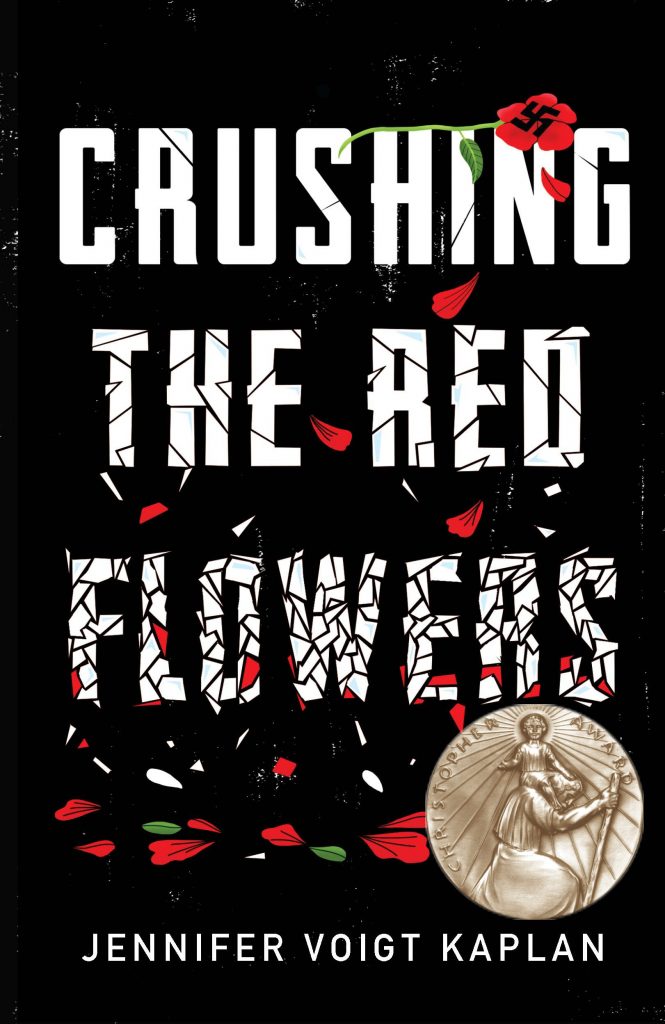**Originally published on MG Book Village**
Writing about emotionally difficult topics for the middle-grade audience can be tricky. How do you introduce tough subjects to young readers in a thought-provoking way without minimizing the event, compromising authenticity, and distressing your readers?

I encountered these challenges when writing my debut middle-grade novel, Crushing the Red Flowers. The book takes place in 1938 Germany over the pogrom known as Kristallnacht (Night of Broken Glass). Writing about one of the most disturbing periods of history was no easy feat and I learned a great deal. Whether you are planning to take on a painful historical event or a weighty contemporary issue, below are five tips that will help you tackle difficult topics for middle-grade readers.
Tip 1 – Set Objectives by Establishing a Baseline of Kid Knowledge and Questioning Your Motives
The first step is to understand what kids already know. You may be surprised to learn that your target readers have major misconceptions or aren’t even aware of the topic. Find out if the topic is part of school curriculum. Read message board discussions on the subject. Talk to educators and other relevant professionals. And of course, ask your target readers what they know.
When conceiving ideas for Crushing the Red Flowers, I asked 4th and 5th graders about the Holocaust after it was introduced to them in school. I ascertained that little was understood about the factors that led up to the war and that there were misunderstandings about why Jewish people did not leave Germany earlier and about the nuanced nature of German resistance.
A children’s writer must be certain of their intentions when undertaking a highly charged subject, so it’s necessary to question your motives from the start. What do you want your readers to internalize? Are you writing to reach those affected? Are you writing to educate the masses? Asking these questions and establishing a baseline of kid knowledge helped me focus my main objective—to provide middle-grade readers a solid introduction to the holocaust—as well as set secondary objectives.
Tip 2 – Define Parameters
After setting objectives, designate parameters specifically for the middle-grade audience. This could mean narrowing a time period, selecting point-of-view, or choosing a setting. For example, a book that takes place in the pre-war years is very different from a book that takes place during the war years. Choosing third person point-of-view over first person point-of-view may soften the content. A sympathetic omniscient narrator could work well to tie fragmented points-of-view and more gently guide the reader through upsetting events. And a story set close to the action is not the same as one set in a neutral location.
I chose to confine Crushing the Red Flowers to 1938 and center it around Kristallnacht. Keeping the story within 1938 allowed me to authentically write about the period and reach middle-grade readers without compromising authenticity or minimizing the events. Given the misconceptions my target readers held, I also decided to alternate perspectives between two twelve-year-old main characters, a German Jewish boy and a boy in Hitler’s Jungvolk.
Tip 3 – Get the Facts Right
Because you’ve committed to writing about a difficult topic for children, you’ve committed to giving them the best you can give. Diligent research is your foundation. When writing Crushing the Red Flowers, I used a three-layer approach to research.
First, the big stuff. Identify primary sources. I conducted interviews with people who lived through the era and read everything I could get my hands on about 1938 Germany: Non-fiction, fiction, academic articles, and credible online sources.
Next, the details. As I wrote, questions emerged. What was the weather in Hannover on certain dates? What foods were hard to obtain in 1938? What did 1930s wallpaper look like in Germany? I researched through library sources and also reached out to historians, like Myrna Goldenberg, professor emerita of Holocaust history at Montgomery College, and Dr. Patricia Heberer-Rice from the Holocaust Memorial Museum.
Last, the minutiae. Even after specific questions were answered, I continued my research to gain a general sense of German styles and mood in the 1930s. I watched movies from the time period, browsed through family portraits housed at the Center for Jewish History, watched old political video clips, and inspected hundreds of interiors at the New York Public Library Picture Collection. Sometimes I found a new detail to weave into my writing, but sometimes I just verified an element already in my novel.
Tip 4 – Write a Stellar Discussion Guide
A discussion guide is a list of questions found at the end of a book that foster conversation. Discussion guides work very well for middle-grade books. They provide educators and parents a manual for encouraging rich conversations. Discussion guides offer a safe stage to talk about difficult elements, help discussion leaders link the material back to children’s everyday lives, allow conversations to flow in greater detail, and help discussion leaders make sure that readers understood the material.
Ideas are freshest on your mind when you are writing, so I recommend adding a few questions to your discussion guide after writing each chapter. Ask about characters’ feelings and reasons for their actions. Incorporate other art forms, like sketching pictures or creating book trailers. And ask plenty of questions that have readers link back to their own lives.
Tip 5 – Take Emotional Breaks
Difficult topics aren’t just difficult for kids. They are difficult for everyone: writers, parents, and educators. Prioritizing self-care is a must. Crushing the Red Flowers took me years to write. That’s a long time to live in 1938 Germany and it was especially taxing because my book is based on true family experiences.
I suggest taking occasional breaks. If it becomes too much for you, it’s okay to step away for short periods. This will not only improve your well-being, it will allow you to see the bigger picture, ensure that you are working towards your objectives, and ultimately improve your ability to connect with middle-grade readers.

